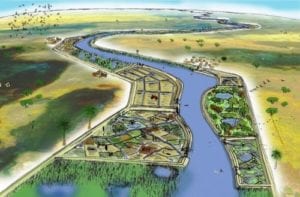International consultancy, engineering and project management service provider Royal HaskoningDHV, has produced a master plan to develop the Senegal River delta and is designing eight polders as a pilot project in the area. The delta is plagued by Typha, an aquatic plant that grows abundantly in the area. The plant’s proliferation limits water access for the population, reduces the potential for agriculture and increases the occurrence of diseases like bilharzia (also known as schistosomiasis) and malaria. The polders will allow intensive usability of the land in the near future and deny the Typha further space for growth.
The client for the project is OMVS, Organisation pour la Mise en Valeur du fleuve Sénégal. OMVS is a governmental organisation of Guinea, Mali, Mauritania and Senegal set-up to manage the Senegal River and its drainage basin. It aims to promote self-sufficiency in food, to improve the income of the local populations and to preserve the natural ecosystems. With a length of 1 800 km, the Senegal River is West Africa’s longest river. Its delta, which lies between the Sahel and the Sahara, is pivotal to the local population’s socio‑economic conditions. Many people live in villages along the banks of the river. In the 1970s, OMVS built two dams to organize the area’s water supply, improve navigation and generate energy. Fawzi Bedredine, project manager at OMVS, says: “Construction of the dams created a large freshwater lake, while flood plains are permanently under water and there has been a sharp reduction in the penetration of salt in the river. In the fresher river delta, the Typha, which flourishes in a freshwater environment, has proliferated massively on the flood plains of the river”. The aquatic plant now plagues a total area of 100,000 hectares. George Peters, project manager at Royal HaskoningDHV, says: “The huge proliferation of the Typha has major consequences for the local people. These aquatic plants prevent them from having access to the river, the flood plains are unavailable as agricultural land and drainage canals become blocked. What’s more, the plants attract birds that eat the crops in the nearby agricultural areas. On top of all this, 90% of the population have contracted bilharzia, a disease that can cause organ failure and is spread via worms and larvae in the river water.”The Royal HaskoningDHV plan is designed to improve the situation of the local population by creating agricultural land and improving access to the water. Eight polders, 63 km of dikes and 60 km of drainage canals will be constructed in the river delta in an area covering between 3 000 and 4 000 hectares.
“Creating the polders will make it possible to use the area for agriculture, thus preventing the Typha from growing and spreading. The local people will again get access to the river and thus to fresh water for irrigation and trade,” explains Peters The design of the polders will be ready in July 2013. In addition to the design, Royal HaskoningDHV is producing a technical and financial plan for construction of the polders and is advising OMVS on the setting up of the management organization.“In 2009 the Dutch Rivierenland Water Board approached us with the request to assist OMVS. Since 2004 the water board has a twinning relation with OMVS and acts as intermediary between OMVS and Dutch knowledge institutes and companies,” points out Peters. The contract for the project is worth €1.7 million and it is being financed by ORIO (Facility for Infrastructure Development), a grant scheme operated by the Netherlands Ministry of Foreign Affairs.








